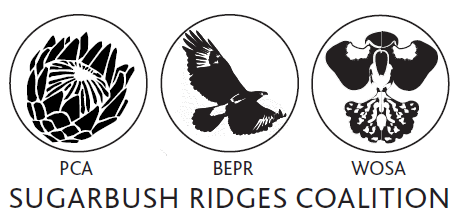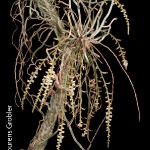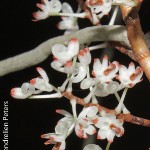Microcoelia
Microceolia is a genus consisting of 31 species endemic to Africa. All species are monopodial and leafless with an extensive branching root system with long roots resembling an untidy birds nest. The roots grow into open clumps that allow a maximum amount of light to reach all of the roots. The roots contain the chlorophyll that aids in photosynthesis. Plants have a stem from which very small, green or white tinged flowers are borne on a flowering stem.
Credit
Johnson, S.D., Bytebier, B., Stärker, H. (2010). Orchids of South Africa: A field guide. Struik Nature, Cape Town, South Africa.
Microcoelia aphylla
Description
Slender leafless epiphyte, with stems up to 400 mm long and only 2 mm in diameter, climbing with hook-like roots. Inflorescences lateral, many all along the stem. 8-16 flowers are white, with contrasting, rust-red sepal tips. Column also rust coloured. Spur short and generally curled. Syn: Solenangis aphylla.
Microcoelia exilis
Description
Slender, leafless epiphyte, with stems up to 40 mm long and 3 mm in diameter. Roots numerous, branching and twisted, not attached tightly to the host. Inflorescences lateral, several and up to 150 mm long with about 50 flowers. Flowers are white, 1.5 mm in diameter. Sepals and petals similar.
Microcoelia obovata
Description
Slender leafless epiphyte with stems up to 30 mm long. Roots are usually well attached to the host. Inflorescences lateral, up to 10 simultaneously up to 90 mm long. Flowers up to 10, white with a yellow brown column and anther cap. Petals and sepals similar and egg shaped.
For more information regarding the preservation of South Africa's wild Orchids or if you would like to get involved please email This email address is being protected from spambots. You need JavaScript enabled to view it. or complete this short form Contact Us and we will contact you.



